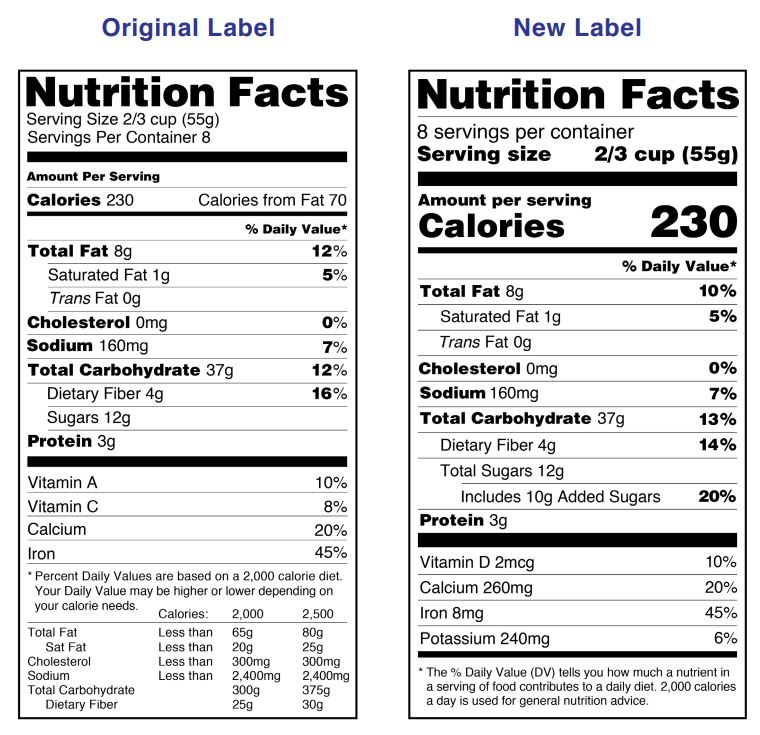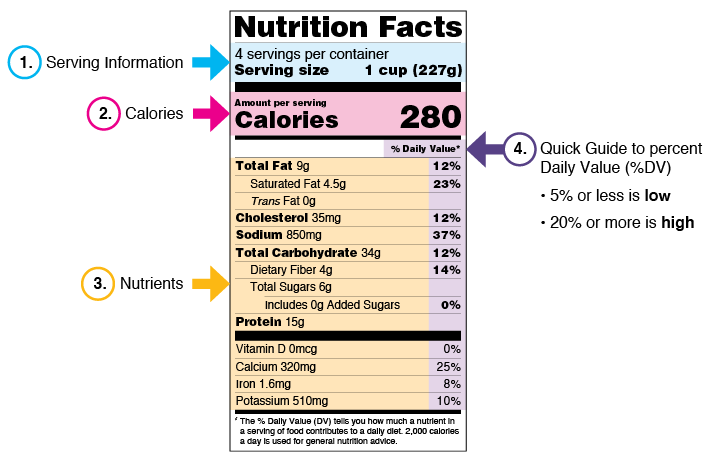2.4 Food Labels
Overview
Understanding the significance of dietary guidelines can make you better equipped to select the right foods the next time you go to the supermarket.
In the United States, the Nutrition Labeling and Education Act (NLEA) passed in 1990 and came into effect in 1994. As a result, all packaged foods sold in the United States must have nutrition labels that accurately reflect the contents of the food products. The FDA regulates what is and what is not allowed to be included on food labels. There are several mandated nutrients and some optional ones that manufacturers or packagers include.
In May 2016, a new Nutrition Facts label for packaged foods was announced. This was the first update since 1990 and the new label reflects new scientific information that makes it easier for consumers to make informed food choices. Figure 2.7 shows a side by side comparison of the original and updated versions. The compliance date for this new label was January 1, 2020 for manufacturers with $10 million or more in annual food sales. Manufacturers with less than $10 million in annual food sales had an additional year to comply – until Jan. 1, 2021. This means that all new products will have the updated food label, but you may still see the original label as products work their way through distribution.
Figure 2.7 Comparison of Original and Updated Nutrition Facts Labels

Some of the changes made to the label include:
- Increased type size for “Calories,” “servings per container,” and “Serving size”
- Bolded type for the number of calories and the “Serving size”
- Actual amounts of vitamin D, calcium, iron, and potassium (in addition to the Daily Value amounts) are required to be listed. Vitamins A and C are now voluntary.
- Improved footnote to better explain the Daily Value
- “Added sugars” in grams and percent Daily Value are required to be listed due to scientific data the impact of added sugars on caloric intake
- “Total Fat,” “Saturated Fat,” “Trans Fat,” “Cholesterol,” “Total Carbohydrates” are still required on the label
- “Calories from fat” has been removed because the type of fat is important
- Updated values for sodium, dietary fiber, and vitamin D (which are all required on the label) based on newer scientific research
- Updated serving sizes that reflect how much consumers are more likely eating today
- Some packages with serving sizes between one and two are required to be labeled as one serving since most consumers will likely eat it in one sitting
- Dual columns for certain products that are larger than a single serving but could be consumed in one sitting will indicate “per serving” and “per package” amounts
Reading the Label
Figure 2.8 shows you what to look for when quickly scanning a food label at the grocery store.
Figure 2.8 How to Read a Nutrition Facts Label

The following information is required by law to be listed on food labels:
Name of product: Sometimes the name of the product includes important information. For example some brands are vegetarian, kosher, gluten-free, etc. It is also important to compare/contrast ingredients in generic and brand name foods.
Serving Size: It’s important to pay attention to how many servings a package contains. Many packages contain multiple servings.
Calories: Pay attention to whether the caloric content of the food is per serving or per package. Also, some food labels indicate calories before or after preparation.
Fats: The food label includes all fats. Note that the label indicates different types of fats. A later chapter will address different fats and how they are important in human nutrition.
Cholesterol: Dietary cholesterol is a major factor in cardiovascular health. Limiting the intake of cholesterol can prevent heart disease.
Sodium: Another major factor in promoting good health is limiting the amount of sodium intake.
Carbohydrates: The food label includes simple and complex carbohydrates. Note that the label indicates different types of carbohydrates; a later chapter will address these and how they are important in human nutrition.
Proteins: Protein intake needs to be carefully monitored because over or under consumption of protein can cause severe issues.
Vitamins and Minerals: There are four vitamins and minerals (Vitamin D, Calcium, Iron, and Potassium) that are required on food labels; however, the label might include more than these four.
Ingredients: The ingredients are listed in order of their content per volume. If sugar is listed as the first ingredient, there is more sugar in the food than any other ingredient. The last ingredient has the least amount in the food.
Name of manufacturer: In addition to the Nutrition Facts, the food label includes the name and contact information for the manufacturer as required by law.
Allergens: Food manufacturers are required to draw specific attention to common allergens such as nuts, milk products, soy, etc. There is no specific location for allergen information, but it should be someplace on the packaging.
Health Claims
Often we hear news of a particular nutrient or food product that contributes to our health or may prevent disease. A health claim is a statement that links a particular food with a reduced risk of developing disease. As such, health claims such as “reduces heart disease,” must be evaluated by the FDA before it may appear on packaging. Prior to the passage of the NLEA products that made such claims were categorized as drugs and not food. All health claims must be substantiated by scientific evidence in order for it to be approved and put on a food label. To avoid having companies making false claims, laws also regulate how health claims are presented on food packaging. In addition to the claim being backed up by scientific evidence, it may never claim to cure or treat the disease.
Structure/Function Claims
Structure/function claims may describe the role of a nutrient or dietary ingredient intended to affect the normal structure or function of the human body, for example, “calcium builds strong bones.” However, the product may not say “calcium restores lost bone” because that would be a therapeutic statement which is regulated under drug law, not food law. In addition, products may characterize the means by which a nutrient or dietary ingredient acts to maintain such structure or function, for example, “fiber maintains bowel regularity,” or “antioxidants maintain cell integrity.” Structure/function claims are not pre-approved by the FDA and must include the disclaimer, “This product is not intended to diagnose, treat, cure, or prevent any disease.”
Nutrient Content Claims
In addition to mandating nutrients and ingredients that must appear on food labels, any nutrient content claims must meet certain requirements. See the table below for some examples. If you want more information on guidelines for nutrient content claims, you can find the FDA’s labeling guidelines here.
Table 2.1 Common Label Terms Defined
| Term | Explanation |
| Calorie/sugar/fat free | The product provides less than 0.5 grams of sugar or fat per serving or less than 5 kcal per serving |
| Reduced calorie/sugar/fat | The product contains at least 25% less kcals, sugar, or fat than the reference food |
| Low fat | The product contains 3 or less grams of fat per serving |
| Low sodium | The product contains fewer than 140 mg of sodium per serving |
| High in ___ | Contains more than 20% of that nutrient’s DV |
| Good source of ___ | Contains 10 to 19% of that nutrient’s DV |
| Light/lite | Contains ⅓ fewer calories or 50% less fat; if more than half of calories come from fat, then fat content must be reduced by 50% or more |
| Organic | Contains 95% organic ingredients |
Enrichment and Fortification
Fortification and enrichment are both ways to add more micronutrients to the foods that we eat. During the processing (refining) of grains, the parts of the grain containing the majority of the vitamins, minerals, and fiber are removed. Whole grain products are made with the entire grain intact, including all the vitamins, minerals, and fiber; therefore, whole grains are more nutritious than refined grains. In fact, many vitamins were discovered when grains were first processed because people began to fall victim to mysterious diseases which we now know are vitamin deficiencies that can be cured by adding the missing vitamins back into an individual’s diet. Now that we know processed grains lack several essential vitamins and minerals, in 1943 the FDA mandated that some of the nutrients lost during the refining of wheat, rice, and corn be replaced to reduce the risk of vitamin deficiencies. The nutrients that are required to be added back are thiamin, niacin, riboflavin, folate, and iron. The addition of vitamins and minerals that are removed during processing is called enrichment. Fortification is the addition of any nutrient to a food that was not originally present in that food. For example, the addition of iodine to table salt. Foods are fortified or enriched in order to improve their nutritional value. Milk is often fortified with vitamin D because vitamin D helps the body absorb the calcium in milk and fat-free milk is enriched with vitamin A because the vitamin A is reduced with the removal of the fat.
Media Attributions
- Side by side comparison of original and new labels © FDA is licensed under a Public Domain license
- How to Use New Food Label © FDA is licensed under a Public Domain license
